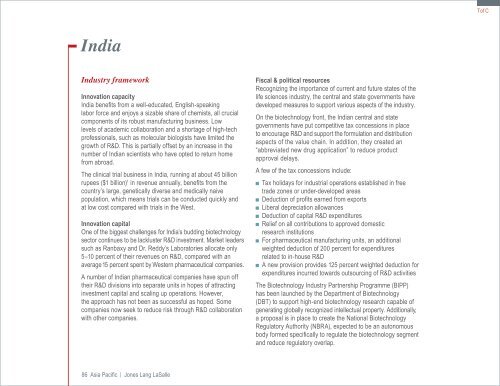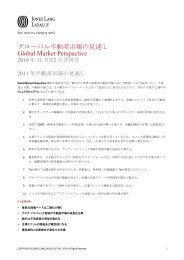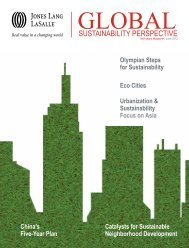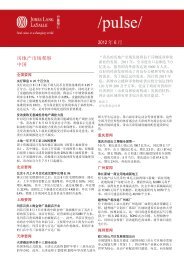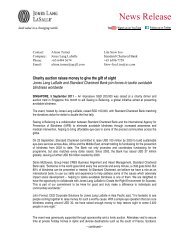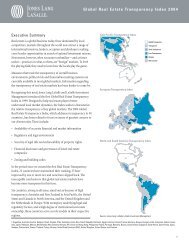Global Life Sciences Cluster Report 2011 - Jones Lang LaSalle
Global Life Sciences Cluster Report 2011 - Jones Lang LaSalle
Global Life Sciences Cluster Report 2011 - Jones Lang LaSalle
You also want an ePaper? Increase the reach of your titles
YUMPU automatically turns print PDFs into web optimized ePapers that Google loves.
India<br />
Industry framework<br />
Innovation capacity<br />
India benefits from a well-educated, English-speaking<br />
labor force and enjoys a sizable share of chemists, all crucial<br />
components of its robust manufacturing business. Low<br />
levels of academic collaboration and a shortage of high-tech<br />
professionals, such as molecular biologists have limited the<br />
growth of R&D. This is partially offset by an increase in the<br />
number of Indian scientists who have opted to return home<br />
from abroad.<br />
The clinical trial business in India, running at about 45 billion<br />
rupees ($1 billion) 1 in revenue annually, benefits from the<br />
country’s large, genetically diverse and medically naive<br />
population, which means trials can be conducted quickly and<br />
at low cost compared with trials in the West.<br />
Innovation capital<br />
One of the biggest challenges for India’s budding biotechnology<br />
sector continues to be lackluster R&D investment. Market leaders<br />
such as Ranbaxy and Dr. Reddy’s Laboratories allocate only<br />
5–10 percent of their revenues on R&D, compared with an<br />
average 15 percent spent by Western pharmaceutical companies.<br />
A number of Indian pharmaceutical companies have spun off<br />
their R&D divisions into separate units in hopes of attracting<br />
investment capital and scaling up operations. However,<br />
the approach has not been as successful as hoped. Some<br />
companies now seek to reduce risk through R&D collaboration<br />
with other companies.<br />
86 Asia Pacific | <strong>Jones</strong> <strong>Lang</strong> <strong>LaSalle</strong><br />
Fiscal & political resources<br />
Recognizing the importance of current and future states of the<br />
life sciences industry, the central and state governments have<br />
developed measures to support various aspects of the industry.<br />
On the biotechnology front, the Indian central and state<br />
governments have put competitive tax concessions in place<br />
to encourage R&D and support the formulation and distribution<br />
aspects of the value chain. In addition, they created an<br />
“abbreviated new drug application” to reduce product<br />
approval delays.<br />
A few of the tax concessions include:<br />
■ Tax holidays for industrial operations established in free<br />
trade zones or under-developed areas<br />
■ Deduction of profits earned from exports<br />
■ Liberal depreciation allowances<br />
■ Deduction of capital R&D expenditures<br />
■ Relief on all contributions to approved domestic<br />
research institutions<br />
■ For pharmaceutical manufacturing units, an additional<br />
weighted deduction of 200 percent for expenditures<br />
related to in-house R&D<br />
■ A new provision provides 125 percent weighted deduction for<br />
expenditures incurred towards outsourcing of R&D activities<br />
The Biotechnology Industry Partnership Programme (BIPP)<br />
has been launched by the Department of Biotechnology<br />
(DBT) to support high-end biotechnology research capable of<br />
generating globally recognized intellectual property. Additionally,<br />
a proposal is in place to create the National Biotechnology<br />
Regulatory Authority (NBRA), expected to be an autonomous<br />
body formed specifically to regulate the biotechnology segment<br />
and reduce regulatory overlap.<br />
Tof C


